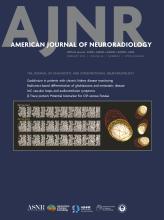Research ArticleUltra-High-Field MRI/Imaging of Epilepsy/Demyelinating Diseases/Inflammation/Infection
Quantitative Susceptibility Mapping in Adults with Persistent Postconcussion Symptoms after Mild Traumatic Brain Injury: An Exploratory Study
Tiffany K. Bell, Muhammad Ansari, Julie M. Joyce, Leah J. Mercier, David G. Gobbi, Richard Frayne, Chantel Debert and Ashley D. Harris
American Journal of Neuroradiology February 2025, 46 (2) 435-442; DOI: https://doi.org/10.3174/ajnr.A8454
Tiffany K. Bell
aFrom the Department of Radiology (T.K.B., J.M.J., D.G.G., R.F., A.D.H.), University of Calgary, Calgary, Alberta, Canada
bHotchkiss Brain Institute (T.K.B., J.M.J., L.J.M., R.F., C.D., A.D.H.), University of Calgary, Calgary, Alberta, Canada
cAlberta Children’s Hospital Research Institute (T.K.B., J.M.J., A.D.H.), University of Calgary, Calgary, Alberta, Canada
Muhammad Ansari
dDepartment of Biomedical Engineering (M.A.), University of Calgary, Calgary, Alberta, Canada
Julie M. Joyce
aFrom the Department of Radiology (T.K.B., J.M.J., D.G.G., R.F., A.D.H.), University of Calgary, Calgary, Alberta, Canada
bHotchkiss Brain Institute (T.K.B., J.M.J., L.J.M., R.F., C.D., A.D.H.), University of Calgary, Calgary, Alberta, Canada
cAlberta Children’s Hospital Research Institute (T.K.B., J.M.J., A.D.H.), University of Calgary, Calgary, Alberta, Canada
Leah J. Mercier
bHotchkiss Brain Institute (T.K.B., J.M.J., L.J.M., R.F., C.D., A.D.H.), University of Calgary, Calgary, Alberta, Canada
eDepartment of Clinical Neuroscience (L.J.M, R.F.,C.D.), University of Calgary, Calgary, Alberta, Canada
David G. Gobbi
aFrom the Department of Radiology (T.K.B., J.M.J., D.G.G., R.F., A.D.H.), University of Calgary, Calgary, Alberta, Canada
fCalgary Image Processing and Analysis Centre (D.G.G., R.F.), University of Calgary, Calgary, Alberta, Canada
Richard Frayne
aFrom the Department of Radiology (T.K.B., J.M.J., D.G.G., R.F., A.D.H.), University of Calgary, Calgary, Alberta, Canada
bHotchkiss Brain Institute (T.K.B., J.M.J., L.J.M., R.F., C.D., A.D.H.), University of Calgary, Calgary, Alberta, Canada
eDepartment of Clinical Neuroscience (L.J.M, R.F.,C.D.), University of Calgary, Calgary, Alberta, Canada
fCalgary Image Processing and Analysis Centre (D.G.G., R.F.), University of Calgary, Calgary, Alberta, Canada
Chantel Debert
bHotchkiss Brain Institute (T.K.B., J.M.J., L.J.M., R.F., C.D., A.D.H.), University of Calgary, Calgary, Alberta, Canada
eDepartment of Clinical Neuroscience (L.J.M, R.F.,C.D.), University of Calgary, Calgary, Alberta, Canada
Ashley D. Harris
aFrom the Department of Radiology (T.K.B., J.M.J., D.G.G., R.F., A.D.H.), University of Calgary, Calgary, Alberta, Canada
bHotchkiss Brain Institute (T.K.B., J.M.J., L.J.M., R.F., C.D., A.D.H.), University of Calgary, Calgary, Alberta, Canada
cAlberta Children’s Hospital Research Institute (T.K.B., J.M.J., A.D.H.), University of Calgary, Calgary, Alberta, Canada

References
- 1.↵
- Champagne AS,
- Yao X,
- Mcfaull SR, et al
- 2.↵
- 3.↵
- 4.↵
- Gumus M,
- Santos A,
- Tartaglia MC
- 5.↵
- 6.↵
- 7.↵
- Chary K,
- Nissi MJ,
- Nykänen O, et al
- 8.↵
- Koch KM,
- Meier TB,
- Karr R, et al
- 9.↵
- 10.↵
- Sader N,
- Gobbi D,
- Goodyear B, et al
- 11.↵
- Kay T,
- Harrington DE,
- Adams R
- 12.↵World Health Organization. The ICD-10 Classification of Mental and Behavioural Disorders: Diagnostic Criteria for Research. Geneva: 1993.
- 13.↵
- 14.↵
- 15.↵
- Salluzzi M,
- Gobbi DG,
- McLean DA, et al
- 16.↵
- 17.↵
- 18.↵
- McCreary CR,
- Salluzzi M,
- Andersen LB, et al
- 19.↵
- Smith SM
- 20.↵
- 21.↵
- 22.↵
- 23.↵
- Jenkinson M,
- Bannister PR,
- Brady JM, et al
- 24.↵
- Desikan RS,
- Ségonne F,
- Fischl B, et al
- 25.↵
- Hua K,
- Zhang J,
- Wakana S, et al
- 26.↵R Core Team. (2020) R: a language and environment for statistical computing. R Foundation for Statistical Computing, Vienna, Austria. https://www.R-project.org/
- 27.↵
- 28.↵
- 29.↵
- 30.↵
- 31.↵
- 32.↵
- Ghodadra A,
- Alhilali L,
- Fakhran S
- 33.↵
- 34.↵
- 35.↵
- 36.↵
- Leech R,
- Sharp DJ
- 37.↵
- 38.↵
- 39.↵
- 40.↵
- 41.↵
- Yaldizli Ö,
- Glassl S,
- Sturm D, et al
- 42.↵
- Sepulcre J,
- Masdeu JC,
- Goñi J, et al
In this issue
American Journal of Neuroradiology
Vol. 46, Issue 2
1 Feb 2025
Advertisement
Tiffany K. Bell, Muhammad Ansari, Julie M. Joyce, Leah J. Mercier, David G. Gobbi, Richard Frayne, Chantel Debert, Ashley D. Harris
Quantitative Susceptibility Mapping in Adults with Persistent Postconcussion Symptoms after Mild Traumatic Brain Injury: An Exploratory Study
American Journal of Neuroradiology Feb 2025, 46 (2) 435-442; DOI: 10.3174/ajnr.A8454
0 Responses
Jump to section
Related Articles
Cited By...
- No citing articles found.
This article has not yet been cited by articles in journals that are participating in Crossref Cited-by Linking.
More in this TOC Section
Similar Articles
Advertisement











